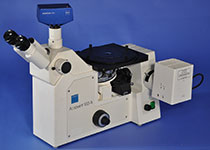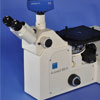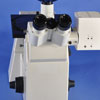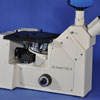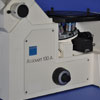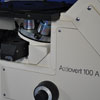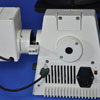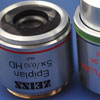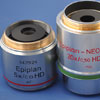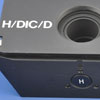Product Overview:
This is a hard to find metallurgical microscope, and even harder to find when the frame is made for DIC and Darkfield.
It is precision made in Germany.
While it is not new, it is still of outstanding German quality.
Designed and Engineered to the highest standards, this microscope in it’s day was the top of the line available for materials analysis and metallurgical laboratories. It has been reconditioned to the original factory settings.
Capable of all three of the most useful lighting techniques for materials and metal examination.
Reflected Brightfield – EpiIllumination: Set the reflector slider to the “H” position. This gives the common epiillumination found in any standard metallograph. Direct (brightfield) light is reflected off the specimen and goes back into the objective for viewing.
Darkfield Microscopy: Set the reflector slider to “D” position for darkfield. Darkfield in reflected light requires several design changes in the lighting system. First, the objectives must be Darkfield. That means they are marked “HD” (brightfield/darkfield). The German name is (Hell, Dunkel), hence the HD. Secondly, those objectives will be larger diameter. So that means the objective nosepiece must have larger size threads to accommodate. There are also other internal parts in the light path that are needed for Darkfield. The darkfield disc is located in the reflector slider. Seeing your images with this lighting technique will give you the ability to view like you hadn’t before, seeing what was currently not possible to see.
DIC – Differential Interference Contrast: Set the reflector slider to “DIC” position. This engages the analyzer into the light path. You also have to polarize the light by sliding in the polarizing filter. The DIC prisms are located below the objective. Unless the microscope frame was initially made for DIC, it won’t have these critical slider openings in the objective nosepiece. The objectives also must be DIC certified. They will specifically be stamped DIC on the barrel of the objective.
Individual Components:
Reflector Slider. Part 451364. H/DIC/D.
Eyepiece Pair: Pl 10x/25x. High eyepoint. With diopter adjustment on each eyepiece. Eyepiece part number 444034. These are the wide field 25mm versions. Compared to the 20mm and 22mm versions, these give a much better field of view.
Light source: Halogen, 12V-100W.
Housing part number 447217. With bulb centering adjustment screws.
Lamp housing is side mounted for maximum working space efficiency. If mounted in the back, it can be harder to position the instrument on a working table.
Variable intensity illumination.
Explanation of Light Path Components:
The illumination path has slots for two filters just past the lamp housing. It then has a slider knob to engage a frosted filter which removes the bulb filament from being superimposed over the resultant image. It then has a field iris diaphragm.
After the right-angle beam splitter is a lever that is used to adjust the aperature. This can be closed down so it is seen in the image and the centering of the light can be done.
It then has two centering screws to center the luminous field diaphragm.
Then it has another slot for inserting a loose filter.
After, is a filter holder on a slider system. There are three (25mm diameter) openings. One has a filter that appears to be an ND neutral density filter which cuts down the intensity of the light while not changing the color temperature of the light. This is useful for low power objectives such as the 5x when it can be quite bright. The other two are open.
Gliding Rotatable Stage:
This stage has the ability to “glide” in the X and Y direction. The maximum travel range is 20mm in X and 20mm in Y. You use your hands to move it, holding it from one of the four protruding knobs. The stage also rotates 360 degrees. The stage can easily be centered into the light path. Zeiss part number 471722.
As an option, if customer prefers a standard XY low position movement stage, that can be installed. Those are more normally used for biological applications for use with glass slides. The gliding stage provides a large open platform where various metal specimens can be placed, laying them flat, for observation. The benefit of the inverted plus the large open stage is that even large sized specimens can be viewed. This would be impossible with an upright frame model.
Objectives:
Epiplan 5x/0.13, Infinity/-. HD. (darkfield, brightfield). Thread size M27. Part Number 442924.
Epiplan Neofluar 20x/0.50, Infinity/0. HD, DIC. (darkfield, brightfield, DIC). Thread size M27. Part Number 442345.
Epiplan Neofluar 50x/0.80, Infinity/0. HD, DIC. (darkfield, brightfield, DIC). Thread size M27. Part Number 442355.
Epiplan Neofluar 100x/.90, Infinity/0. HD DIC. (darkfield, brightfield, DIC). Thread size M27. Part Number 442385.
Nosepiece has one empty space (capped off) in case another objective needs to be added.
DIC Sliders:
DIC slider for Objective lens Epiplan Neofluar 50x / 0.80. Part number 444464.
Optional. Not Included: (DIC slider for Objective lens Epiplan Neofluar 20x)
Optional. Not Included: (DIC slider for Objective lens Epiplan Neofluar 100x)
Objective Nosepiece:
Quintuple (5-Place) nosepiece for holding up to five objective lenses.
Nosepiece is made with the larger thread size M27. That is a 27mm thread. The smaller RMS threads are only 20.32mm. The larger size objective is needed to allow a lot more light to enter the objective for darkfield.
Nosepiece has DIC slots under each objective. This is essential for DIC. If you have a nosepiece w/o these slots, you can’t use it for DIC. And due to the extreme precision required for aligning, you never want to have to replace the objective turret.
Head:
Binocular viewing head.
Dual ports for two different cameras. One port located on the top of the head and one on the side of the head.
One port is capped off and the other port has a c-mount adapter, ready for mounting of camera.
Includes C-mount camera adapter, 1x, part number 456105.
Binocular phototube with two ports. Part number 451325.
Phototube with left-hand pushrod with 2 beam splitting positions: pushed in: 70% of the light to the upper port and 30% to the binocular tube, pulled out: 70% of the light laterally reflected out and 30% to the binocular tube.
It is suggest to mount a camera to the top port and a video camera on the lateral (side) port.
Right-hand shutter: when pulled out: shutter remains open for observation.
When pushrod is pushed in: the shutter on the eyepiece side is closed, no observation through the tube, no entrance of stray light.
Frame Markings:
Axiovert Part number 451385, 451319.
Made in Germany by Carl Zeiss.
CE certification.
Power Supply: Voltage selectable between 115 to 230 VAC. 50/60 Hz.
Notes:
This instrument has been carefully refurbished and completely tested.
We guarantee the functionality of this equipment.
Options:
Camera is shown in photos but is sold separately. Camera is not included with this item.



